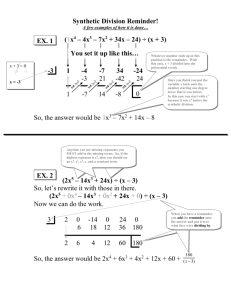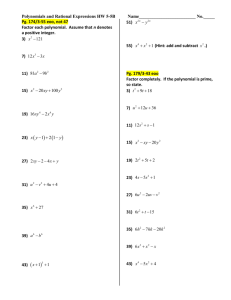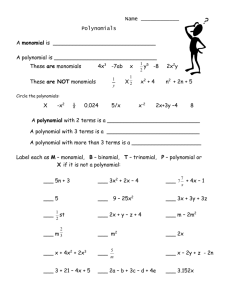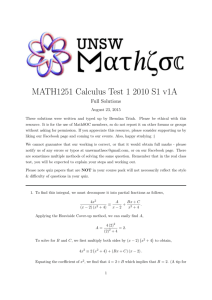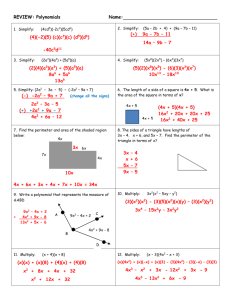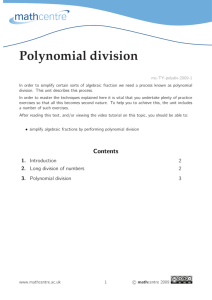Algebra I - Polynomials
advertisement
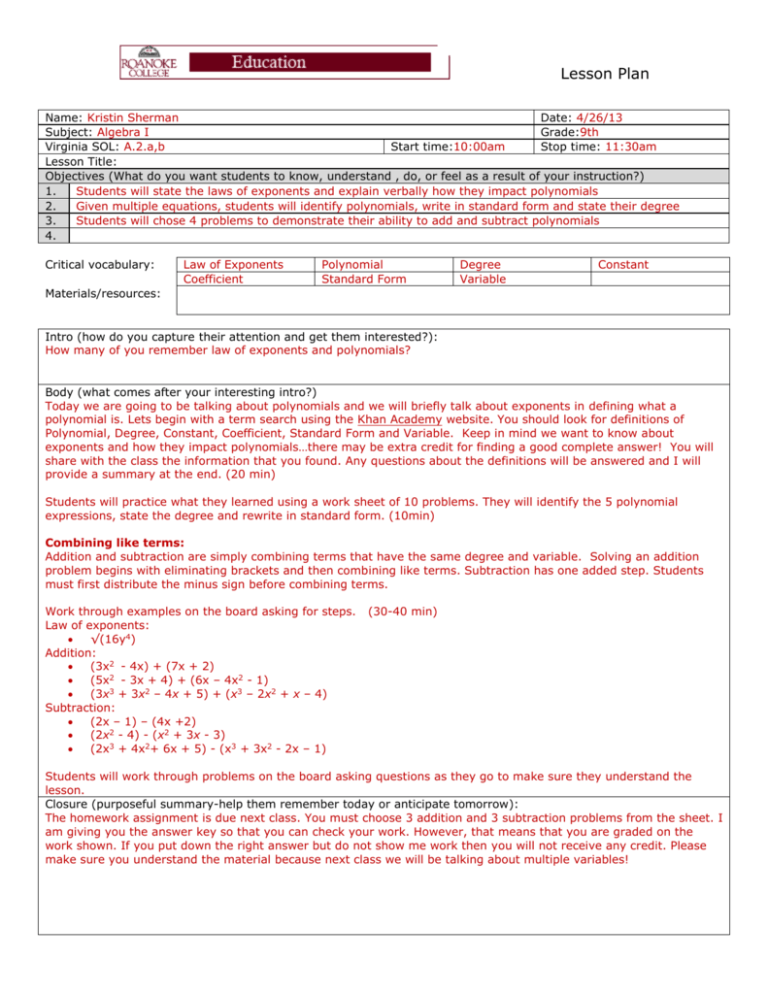
Lesson Plan Name: Kristin Sherman Date: 4/26/13 Subject: Algebra I Grade:9th Virginia SOL: A.2.a,b Start time:10:00am Stop time: 11:30am Lesson Title: Objectives (What do you want students to know, understand , do, or feel as a result of your instruction?) 1. Students will state the laws of exponents and explain verbally how they impact polynomials 2. Given multiple equations, students will identify polynomials, write in standard form and state their degree 3. Students will chose 4 problems to demonstrate their ability to add and subtract polynomials 4. Critical vocabulary: Law of Exponents Coefficient Polynomial Standard Form Degree Variable Constant Materials/resources: Intro (how do you capture their attention and get them interested?): How many of you remember law of exponents and polynomials? Body (what comes after your interesting intro?) Today we are going to be talking about polynomials and we will briefly talk about exponents in defining what a polynomial is. Lets begin with a term search using the Khan Academy website. You should look for definitions of Polynomial, Degree, Constant, Coefficient, Standard Form and Variable. Keep in mind we want to know about exponents and how they impact polynomials…there may be extra credit for finding a good complete answer! You will share with the class the information that you found. Any questions about the definitions will be answered and I will provide a summary at the end. (20 min) Students will practice what they learned using a work sheet of 10 problems. They will identify the 5 polynomial expressions, state the degree and rewrite in standard form. (10min) Combining like terms: Addition and subtraction are simply combining terms that have the same degree and variable. Solving an addition problem begins with eliminating brackets and then combining like terms. Subtraction has one added step. Students must first distribute the minus sign before combining terms. Work through examples on the board asking for steps. Law of exponents: √(16y4) Addition: (3x2 - 4x) + (7x + 2) (5x2 - 3x + 4) + (6x – 4x2 - 1) (3x3 + 3x2 – 4x + 5) + (x3 – 2x2 + x – 4) Subtraction: (2x – 1) – (4x +2) (2x2 - 4) - (x2 + 3x - 3) (2x3 + 4x2+ 6x + 5) - (x3 + 3x2 - 2x – 1) (30-40 min) Students will work through problems on the board asking questions as they go to make sure they understand the lesson. Closure (purposeful summary-help them remember today or anticipate tomorrow): The homework assignment is due next class. You must choose 3 addition and 3 subtraction problems from the sheet. I am giving you the answer key so that you can check your work. However, that means that you are graded on the work shown. If you put down the right answer but do not show me work then you will not receive any credit. Please make sure you understand the material because next class we will be talking about multiple variables! Homework: Worksheets with answer key are given. Work must be shown for credit Assessment: (How will you assess if they have mastered your objectives? Be specific.) Graded homework sheet. In - class term definition discussion. Questions have been encouraged throughout class and will help me better understand what to focus on next class. Pre-assessment: (How will you know if your students already know what you are teaching?) Question asked during introduction to determine knowledge level. Students with prior knowledge will help students who are struggling. Are you differentiating lesson content, process, or product by readiness, interest, or learning profile? Explain below. content process Students come up with their own definitions of terms product readiness Pre-assessment: students who are advanced will help others to keep them involved interest Students can choose the homework problems they’d like to work on out of the sheet given. Video and lecture For cooperative learning explain how you have insured: positive interdependenceindividual accountabilitygroup processingsocial skillsface-to-face interaction- Notes (So, how did it go? What will you change to make it better? Do it now or you’ll forget.) learning profile Polynomial Worksheet Choose 5 Addition Choose 5 Subtraction Addition Problems: 1. (4x2 + 4x + 1) + (4x + 20) 2. (–7x2 + 9x – 15) + (8x – 8) 3. (5x3 – 6x + 10) + (x3 + 10x – 9) 4. (3x2 + 3x – 9) + (5x2 + 7x3 – 4) 5. (8x2 + 4x + 1) + (5x2 + 4x + 16) 6. (–x2 + 5x + 9) + (–x2 + 6x + 9) 7. (–12x3 – 8x2 – 7) + (6x3 + 9x2 – x) 8. (2x3 – 7x2 + 16) + (6x3 + 5x2 – 1) 9. (9x2 – 7x + 55) + (3x + 8) 10. (7x3 + 4x + 1) + (4x2 + 20x5) Subtraction Problems: 11. (6x2 + 4x + 1) – (4x + 20) 12. (–7x9 + 12x6 – 12) – (5x9 + 4x6 – 9) 13. (8x3 – 6x + 10) – (x3 + 10x – 9) 14. (4x8 + 3x – 34) – (5x8 + 70x – 42) 15. (–9x2 + 44x + 2) – (7x2 + 10x + 99) 16. (–8x2 + 15x + 28) – (–x2 + 44x + 9) 17. (–16x3 – 12x2) – (6x3 – 11x2 – x) 18. (4x6 – 9x7 + 16) – (5x6 + 25x7 – 10) 19. (9x2 – 7x + 65) – (11x + 8x2) 20. (9x5 + 4x + 1) – (9x3 + 2x5) Answer Key: 1. 4x2 + 8x +21 2. –7x2 + 17x – 23 3. 6x3 + 4x + 1 4. 7x3 + 8x2 + 3x – 13 5. 13x2 + 8x + 17 6. –2x2 + 11x + 18 7. –6x3 + x2 – x – 7 8. 8x3 – 2x2 + 15 9. 9x2 – 4x + 63 10. 20x5 + 7x3 + 4x2 + 4x + 1 11. 6x2 – 19 12. –2x9 + 8x6 – 3 13. 7x3 – 16x + 19 14. –x8 – 67x + 8 15. –16x2 + 34x – 97 16. –7x2 – 29x + 19 17. –10x3 – x2 + x 18. –x6 – 34x7 + 26 19. x2 – 18x + 65 20. 7x5 – 9x3 + 4x + 1 Am I a Polynomial? Circle the problem that are polynomials and identify the degree. Beside the problem rewrite the equation in standard form. 1. √𝑥 + 4 2. 3𝑥 2 − 2𝑥 + 5 1 3. 𝑥 3 + 𝑥 − 1 4. √16𝑥 4 + 3𝑥 3 − 2 5. √9 𝑥 − 5𝑥 2 − 2𝑥 6 + 99 Answers: 1. Not a polynomial because there is a square root applied to a variable 2. Trinomial, 2nd degree, 3𝑥 2 − 2𝑥 + 5 3. Not a polynomial because there is a variable raised to a fraction 1 1 4. Trinomial, 3rd degree, 3𝑥 3 + (42 )2 ∗ (𝑥 4 )2 – 2 = 3𝑥 3 + 4𝑥 2 − 2 5. Polynomial, 6th degree, −2𝑥 6 − 5𝑥 2 + 3𝑥 + 99
